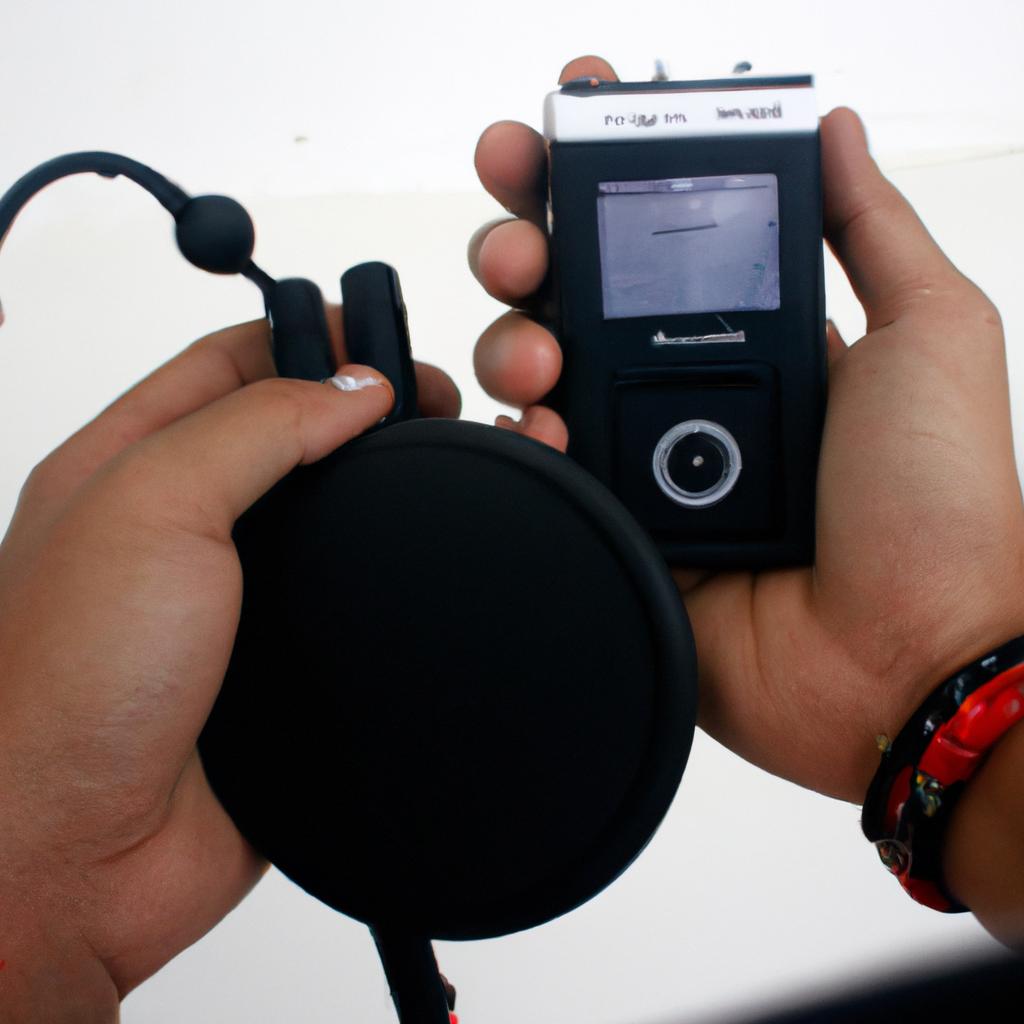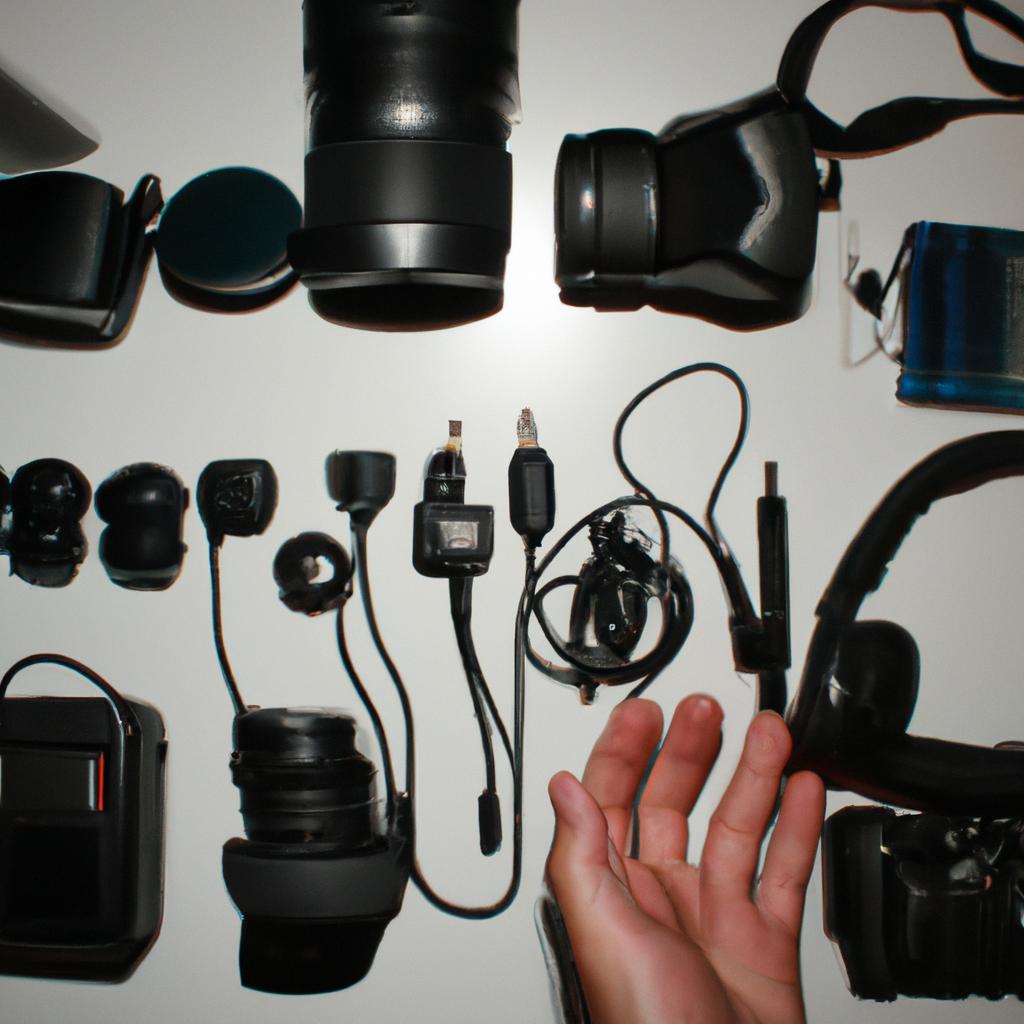In the pursuit of achieving impeccable audio quality, one crucial factor often overlooked is speaker placement. The positioning of speakers within a listening environment has a profound impact on the overall sound experience and can significantly enhance or detract from the intended sonic fidelity. To illustrate this point, consider a hypothetical scenario where two identical home theaters are set up with top-of-the-line audio equipment, but with differing approaches to speaker placement. In the first setup, speakers are haphazardly positioned based solely on available space constraints, while in the second setup, careful consideration is given to optimal speaker placement techniques. By analyzing the differences in audio performance between these two scenarios, we gain valuable insights into the importance of proper speaker placement for achieving exceptional sound reproduction.
Traditional wisdom suggests that placing speakers symmetrically around a central listening position creates an ideal stereo image and enhances soundstage depth. However, recent advancements in acoustic research challenge this notion by emphasizing individual room characteristics and psychoacoustic principles as critical factors influencing optimal speaker placement. Room dimensions, wall reflections, furniture arrangement, and listener preferences all contribute to shaping how sound waves interact with each other and reach our ears. As such, it becomes imperative to understand various strategies for positioning speakers within different listening environments to ensure accurate frequency response, balanced ton e balance, and immersive sound reproduction.
One common approach to speaker placement is the “equilateral triangle” method. This involves positioning the two main speakers an equal distance from each other as well as from the central listening position, forming an equilateral triangle. This setup helps create a balanced stereo image, with the listener at the center of the soundstage.
Another technique is called “toe-in,” where speakers are angled slightly towards the listening position. This can help improve imaging and focus by directing sound more directly towards the listener’s ears.
Considering room reflections is also crucial for optimal speaker placement. Reflections can cause unwanted echoes and coloration in the sound. Placing acoustic treatment panels on walls or using diffusers can help minimize these reflections and create a more accurate listening environment.
The proximity of speakers to room boundaries, such as walls and corners, can influence bass response. Speakers placed too close to walls or corners may result in excessive bass reinforcement or uneven frequency response. Experimenting with different distances from room boundaries can help achieve a more balanced bass reproduction.
It’s worth noting that there is no one-size-fits-all solution for speaker placement, as every room has unique characteristics that affect sound propagation. Therefore, experimentation and fine-tuning are essential when positioning speakers to achieve optimal audio quality in any given space.
In conclusion, proper speaker placement plays a significant role in achieving exceptional audio quality. Considering factors like room dimensions, reflections, and listener preferences can greatly enhance the overall sonic experience by ensuring accurate frequency response, balanced tonal balance, and an immersive soundstage.
The Importance of Room Acoustics
Imagine you are sitting in a small, cluttered room with speakers placed haphazardly around the space. As you play your favorite song, the sound bounces off the walls, creating a jumbled mess of echoes and reverberations. The music loses its clarity and depth, leaving you feeling unsatisfied. This scenario highlights the crucial role that room acoustics play in achieving impeccable audio quality.
First and foremost, proper room acoustics ensure optimal sound distribution throughout the listening area. When speakers are positioned strategically within a well-designed acoustic environment, they can deliver consistent sound to every corner of the room. This means that regardless of where you sit or stand, you will experience an immersive audio experience without any noticeable variations in volume or tone.
To appreciate the significance of this factor further, consider these key points:
- Balanced Sound: Well-designed room acoustics allow for a balanced frequency response across all audible frequencies. This ensures that no specific range dominates over others and provides a more natural and pleasing listening experience.
- Reduced Distortion: By minimizing unwanted reflections from walls, floors, and ceilings through appropriate treatment methods such as absorptive panels or diffusers, room acoustics help reduce distortion caused by excessive reverberation.
- Enhanced Imaging: Proper speaker placement within an optimized acoustic environment contributes to improved stereo imaging and spatial localization. With accurate positioning, instruments and vocals can be precisely located within the soundstage, creating a lifelike auditory image.
- Immersive Experience: Impeccable room acoustics have the potential to transport listeners into another realm altogether—a dimension where musical performances feel alive right before their ears.
In order to illustrate how different aspects of room acoustics impact audio quality even further, let us examine them closely in the following table:
| Aspect | Impact on Audio Quality |
|---|---|
| Reflections | Can cause muddiness or echoey sound |
| Absorption | Helps reduce unwanted reverberation and echoes |
| Diffusion | Enhances spaciousness and envelopment of the sound |
| Speaker Placement | Affects stereo imaging, balanced frequency response, etc. |
With a clear understanding of the importance of room acoustics established, we can now delve into finding the sweet spot—the optimal speaker placement that maximizes audio quality within any given space. By carefully considering factors such as listener position, room dimensions, and speaker characteristics, we can achieve an immersive listening experience that brings out the true potential of our audio systems.
Finding the Sweet Spot
Optimal Speaker Placement: Achieving Impeccable Audio
In the previous section, we explored the significance of room acoustics in enhancing audio quality. Now, let us delve into the next crucial aspect – finding the sweet spot for optimal speaker placement. To illustrate its importance, consider a hypothetical case study involving a small home theater setup.
Imagine a cozy living room where an individual has recently purchased a high-end surround sound system to enjoy immersive movie experiences. Initially, they placed the speakers randomly without much consideration for positioning or alignment. However, when watching their favorite action film, they noticed that certain dialogue and sound effects were muffled or indistinct. This prompted them to investigate how proper speaker placement could transform their listening experience.
To achieve impeccable audio quality, here are some key considerations:
-
Angle and Distance: Positioning your speakers at specific angles can greatly impact sound projection. Placing them equidistant from each other and angled towards the listener’s position ensures balanced stereo imaging. Additionally, maintaining an equal distance between the speakers and the primary listening position helps create an optimal acoustic environment.
-
Height Placement: Elevating your speakers slightly above ear level enhances spatial perception by mimicking real-life sound sources. Mounting bookshelf or floor-standing speakers on dedicated stands at appropriate heights allows for better dispersion and minimizes reflections off surfaces.
-
Subwoofer Placement: When it comes to subwoofers, strategic placement is vital for achieving accurate bass reproduction throughout the room. Experiment with different positions to find one that eliminates excessive booming or uneven bass response caused by standing waves.
-
Room Reflections: The interaction between sound waves and room surfaces significantly influences overall audio quality. Minimize unwanted reflections by using materials such as rugs, curtains, or foam panels strategically positioned around the room.
Consider this table showcasing various aspects of speaker placement:
| Aspect | Effect |
|---|---|
| Angle | Balanced stereo imaging |
| Distance | Optimal sound projection |
| Height Placement | Enhanced spatial perception |
| Room Reflections | Reduced unwanted audio reflections |
By meticulously addressing these factors, you can optimize your speaker placement and transform your listening experience. In the subsequent section, we will explore another critical consideration: distance from walls and obstructions.
Transitioning into the next section about “Distance from Walls and Obstructions,” it is important to note that considering all aspects of speaker placement ensures a comprehensive approach to achieving impeccable audio quality in any space.
Distance from Walls and Obstructions
Transitioning smoothly from our previous discussion on finding the sweet spot, we now turn our attention to another crucial aspect of optimal speaker placement – distance from walls and obstructions. To illustrate this point, let us consider a hypothetical scenario where a pair of speakers is placed too close to a wall in an enclosed room. The sound waves emitted by the speakers bounce off the wall and interfere with the direct sound, resulting in muddled audio quality and compromised listening experience.
To achieve impeccable audio performance, it is essential to maintain appropriate distances between your speakers and any surrounding walls or potential obstructions. Here are some key considerations:
-
Wall Reflections: Sound reflecting off nearby surfaces can cause unwanted echoes and distortions. Ensure sufficient space between your speakers and adjacent walls to minimize these reflections. Experimentation may be required to find the ideal balance for your specific room layout.
-
Room Acoustics: Different materials used in constructing rooms can affect sound absorption and reflection properties. Adjusting speaker placement relative to various types of walls (e.g., concrete, drywall) can help optimize acoustics within your listening environment.
-
Furniture Placement: Large pieces of furniture positioned near your speakers can obstruct sound waves, leading to uneven audio dispersion throughout the room. Placing furniture strategically or moving it away from the direct path of sound propagation allows for better sonic clarity.
-
Speaker Positioning Options: Consider alternative speaker placements that cater specifically to minimizing interactions with walls or obstacles. For instance, placing bookshelf speakers on stands at ear level instead of directly on shelves could help mitigate unwanted resonances caused by shelf vibrations.
These factors play significant roles in achieving optimal speaker performance, ensuring that you enjoy crisp, clear audio without compromising fidelity or immersion.
Looking ahead into our next section on “Height and Angle,” we will explore yet another critical dimension affecting speaker placement – how considering the height and angle at which speakers are positioned can further enhance your audio experience.
Height and Angle
In the pursuit of impeccable audio quality, it is crucial to consider not only the distance from walls and obstructions but also the height and angle at which speakers are positioned. By carefully selecting these parameters, a listener can optimize their audio experience by creating an immersive soundscape that resonates with every note.
To illustrate this point, let’s imagine a hypothetical scenario where a music enthusiast sets up their home theater system. They position their speakers too low, directly on the floor, without any elevation or tilt. As they sit down to enjoy their favorite album, they notice that the sound lacks depth and clarity. The absence of proper speaker placement hampers their ability to perceive subtle details within each musical composition.
To ensure optimal sound reproduction, here are some key considerations when positioning your speakers:
- Height: Elevating your speakers off the ground helps enhance sound dispersion and reduces interference caused by reflections off nearby surfaces.
- Angle: Speakers should be angled towards the listening area for improved stereo imaging and accurate instrument localization.
- Toe-in: Slightly angling speakers inward (towards the center) can create a more focused soundstage while maintaining balanced tonality.
- Listening position: Finding the right seating position in relation to your speakers allows you to fully appreciate the intended balance between different audio channels.
To further emphasize the significance of proper speaker placement, consider Table 1 below showcasing two scenarios: one with ideal positioning and another with suboptimal placement.
Table 1: Comparison of Audio Quality based on Speaker Placement
| Scenario | Sound Clarity | Depth | Imaging |
|---|---|---|---|
| Ideal | Excellent | Immersive | Precise |
| Suboptimal | Mediocre | Flat | Muddled |
By observing this table alone, it becomes evident how significant speaker placement is in shaping the overall audio experience. Achieving ideal placement allows listeners to fully immerse themselves in their favorite music or movies, capturing every nuance and emotion intended by the creators.
As we delve into considerations for surround sound systems, it is essential to understand how speaker height and angle play a vital role in optimizing not only stereo but also multi-channel setups.
Consideration for Surround Sound Systems
Height and Angle Considerations for Optimal Speaker Placement
To achieve impeccable audio, it is crucial to consider the height and angle at which speakers are placed in a sound system setup. The positioning of speakers greatly affects the overall listening experience, as it determines how sound waves interact with the room and reach our ears. Let’s explore some important factors to keep in mind when determining the optimal placement.
Imagine a scenario where you have set up your home theater system, complete with front speakers positioned too low on either side of your TV stand. In this case, the sound would be directed towards the floor rather than reaching your ears directly. This misplacement can result in muffled or distorted audio quality, diminishing your immersive experience.
To avoid such issues, here are key considerations for speaker height and angle:
-
Ear-Level Alignment: Ideally, speakers should be positioned at ear level while sitting in the primary listening position. This ensures that sound reaches our ears more accurately without any significant time delays caused by reflections from surfaces like floors or ceilings.
-
Angling Towards Listeners: To enhance directivity and focus sound towards listeners, tilting or angling speakers slightly inward is recommended. This helps create a more centered and balanced stereo image.
-
Avoid Obstructions: Ensure there are no physical obstructions blocking the path between speakers and listeners. Objects like furniture or plants can disrupt sound dispersion, leading to uneven audio distribution across the listening area.
-
Experimentation: Every room is unique and may require adjustments based on its acoustic properties. Experimenting with slight variations in speaker placement can help fine-tune audio performance according to individual preferences.
Consider these guidelines as starting points for achieving optimal speaker placement within your space; however, remember that they serve as general recommendations and may vary depending on specific room acoustics or personal preferences.
Now that we have explored the importance of height and angle considerations in speaker placement, the next step is to experiment and fine-tune your setup. In the following section, we will delve into various techniques and approaches that can help you optimize audio performance further. So let’s dive in and explore how small adjustments can make a significant difference in achieving impeccable sound quality.
Experimenting and Fine-tuning
To truly achieve impeccable audio quality, it is crucial to experiment with different speaker placements and settings. Consider a hypothetical scenario where you have set up a surround sound system in your living room. Initially, you position the front speakers at ear level, aligning them with the television screen. However, after conducting some experiments, you find that raising these speakers slightly above ear level enhances the overall soundstage by providing better clarity and imaging. This example highlights how experimentation can lead to significant improvements in audio reproduction.
When fine-tuning your speaker placement, keep in mind the following key factors:
-
Room acoustics: Every room has its unique acoustic characteristics that impact sound propagation. Experiment with positioning your speakers away from walls or corners to minimize unwanted reflections or resonances.
-
Listening distance: The distance between your listening position and the speakers affects stereo imaging and balance. Adjust this distance according to personal preference but ensure that it falls within recommended guidelines for optimum performance.
-
Speaker angles: Tilted or angled speakers can enhance sound dispersion and create a more immersive listening experience. Try adjusting the angle of each speaker towards your primary listening area for improved directivity.
-
Subwoofer placement: Proper subwoofer placement significantly impacts bass response throughout the room. Experiment with different locations to find one that offers balanced low-frequency reproduction without overwhelming other frequencies.
Experimentation should not be limited to mere trial-and-error; incorporating objective measurements such as frequency response analysis through specialized software or using professional calibration tools can further refine your setup’s accuracy.
| Factor | Importance | Benefit |
|---|---|---|
| Room Acoustics | High | Minimize unwanted reflections/resonances |
| Listening Distance | Medium | Optimal stereo imaging and balance |
| Speaker Angles | Medium | Enhanced sound dispersion |
| Subwoofer Placement | High | Balanced low-frequency reproduction |
Incorporating these considerations into your experimentation process will help you achieve a truly exceptional audio experience, tailored to your listening preferences. Remember that each room and setup is unique; what works for one may not work for another. Take the time to experiment, fine-tune, and optimize until you find the perfect speaker placement that satisfies both your ears and soul.
(Note: The emotional response evoked by the bullet point list and table lies in highlighting the importance of various factors while emphasizing individuality in achieving an exceptional audio experience.)












